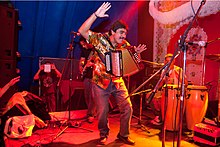Celso Piña
Celso Piña | |
|---|---|
 Celso Piña in 2012. | |
| Background information | |
| Born | April 6, 1953 Monterrey, Nuevo León; México |
| Genres | Cumbia, Tropical, Sonidero, Vallenato |
| Occupation(s) | Singer-songwriter, musician, producer |
| Instrument(s) | Vocals, Accordion |
| Labels | La Tuna |
| Website | celso |
Celso Piña (born April 6, 1953) is a professional singer, composer, arranger, and accordionist[1] mainly in the genre of cumbia.
Celso Piña is a pioneer in the mixture and fusion of tropical sounds with many of his works having elements of musica norteña, sonidero, ska, reggae, rap/hip-hop, R&B, etc. Piña is also known as El Rebelde del acordeón or the Cacique de la Campana.
Piña started playing music in his small town with his brothers Eduardo, Rubén and Enrique. Together they would go to several homes and perform for local citizens, especially teenage girls from their neighborhood.
In 1980, Celso Piña bought his first accordion and was introduced to the world of cumbia. He spent numerous hours of practice and work in the popular district of Colonia Independencia, south of the city of Monterrey, Mexico. Having lived for a majority of his life there, he titled one of his songs Mi colonia Independencia, which is located at the heavily populated area of Cerro de la Campana at Monterrey.
Piña's group decided to change their musical rhythm to encompass a more tropical style during the mid-1980s after having seen Aníbal Velásquez and Alfredo Gutiérrez in concert at "Baile de las Cintas (reproducción of música mediante cintas)". The group decided to switch into the genre of cumbia, and became what today is Celso Piña y su Ronda Bogotá.
Piña taught himself how to play the accordion with no formal training. As a result he was able to create the unique sound he is well known for. His most popular songs include, La cumbia de la paz, El tren, Como el viento and La piragua. José Barros was featured in the song Sufran con lo que yo gozo along with Mexican singer Gloria Trevi.
Celso has done several successful international tours that included countries as Germany, Spain, Portugal, Denmark, Sweden, Czech Republic, Italy, France, Morocco, Colombia, Nicaragua, Guatemala, Argentina, Chile, Canada and the United States.
Discography
- Dile (1996)
- Mis primeras grabaciones (2001)
- Barrio bravo (2001)
- Trayectoria (2002)
- Rebelde (2002)
- Mundo Colombia (2002)
- Pachanguero (2002)
- Desde Colombia (2002)
- Super Seis (2003)
- Una Visión (2003)
- El Canto de un Rebelde para un ... (2004)
- México y su Música (2005)
- 20 Grandes Éxitos (2005)
- Línea de Oro (2006)
- Cúmbia de la Paz (2006)
- 12 Grandes Éxitos Vol.1 (2007)
- 12 Grandes Éxitos Vol.2 (2007)
- Sin Fecha de Caducidad (2009)
- Celso Piña - Zona Preferente: En vivo desde el Auditorio Nacional
References
- ^ Hernandez, Deborah Pacini (2009-12-28). Oye como va!: hybridity and identity in Latino popular music. Temple University Press. pp. 135–. ISBN 978-1-4399-0090-1. Retrieved 23 September 2011.
